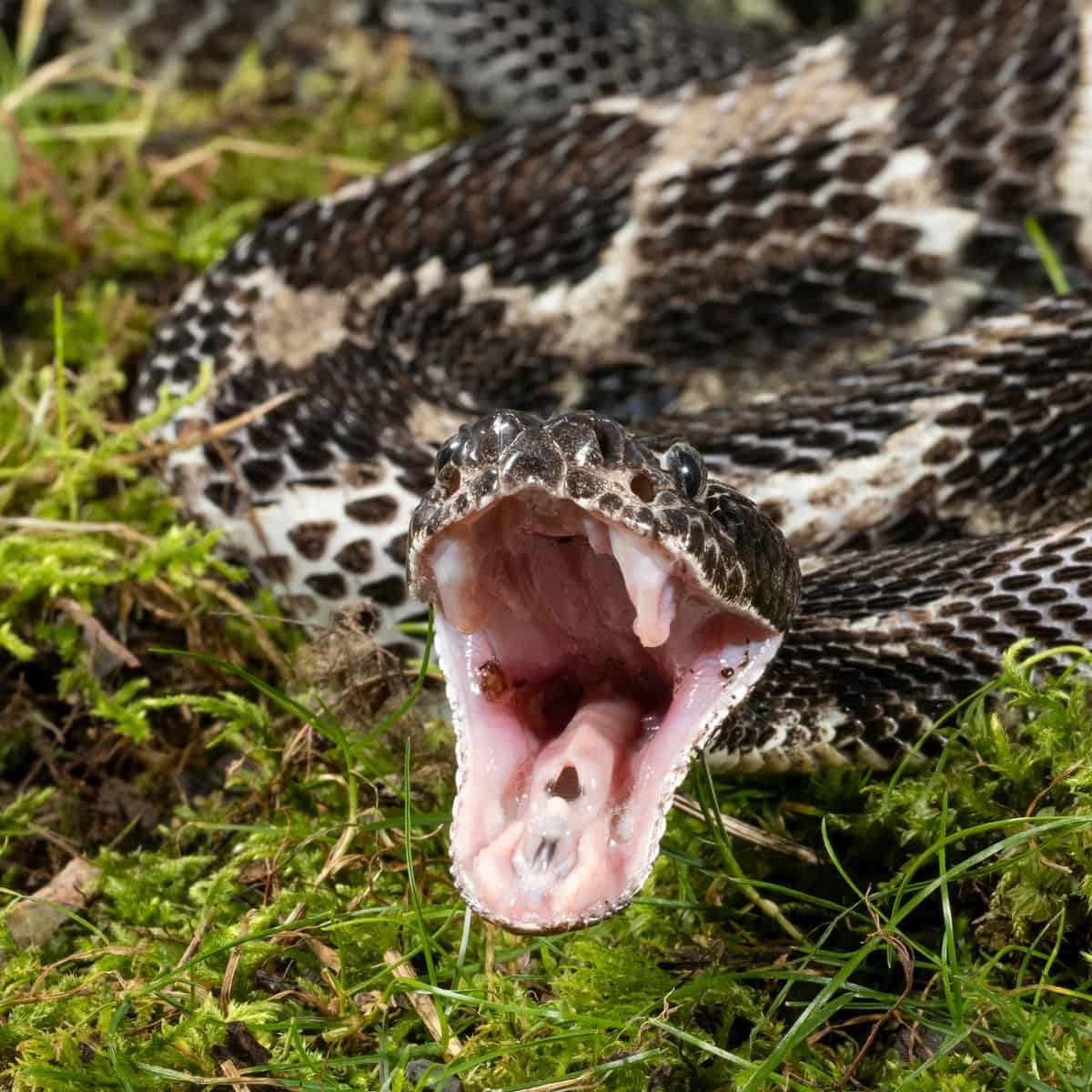Key Points:
- Out of the 21 snake species in Pennsylvania, two are venomous rattlesnakes: timber rattlesnakes and eastern massasauga rattlesnakes.
- While timber rattlesnakes are present throughout most of the state, eastern massasaugas are rarer and usually only found in the state’s northwestern corner.
- At 36-60 inches long, timber rattlesnakes are bigger than eastern massasaugas, which measure 20-30 inches long.
While there are more than 20 types of snakes living in Pennsylvania, only two species are venomous rattlesnakes. Pennsylvania’s rattlesnakes are secretive and sometimes feared by people, even though they are generally peaceful animals and are very important for the environment. These snakes help to keep the population of small mammals (and their pests, such as ticks) that carry diseases under control. Here we’ll help you better understand these unique creatures, so let’s take a closer look at the two types of rattlesnakes in Pennsylvania!
1. Timber Rattlesnakes
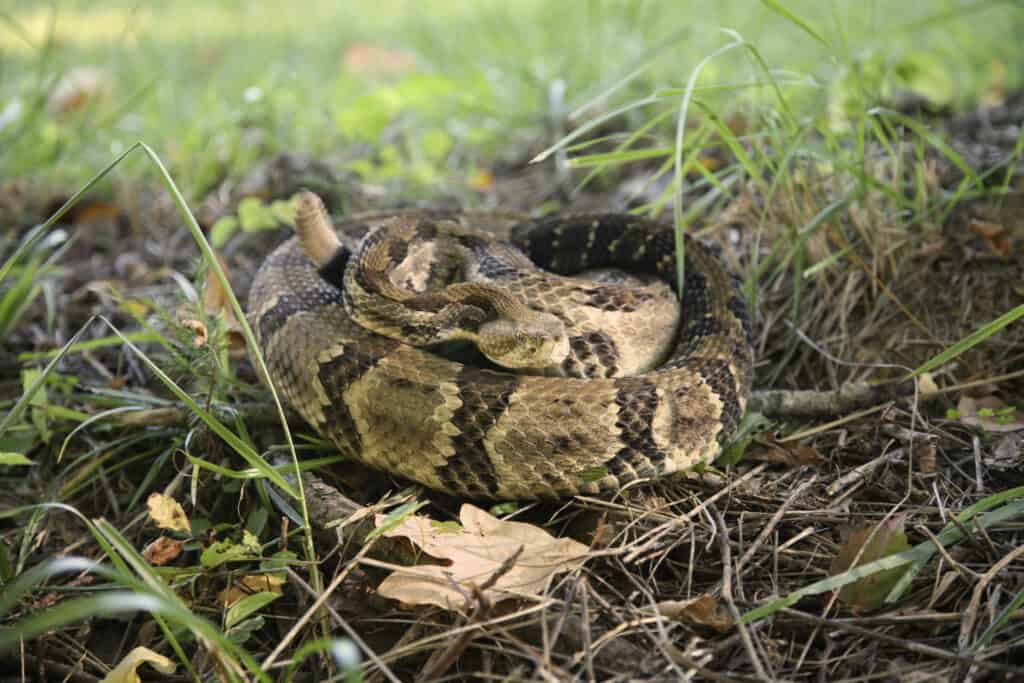
Timber rattlesnakes are extremely venomous, but they are not typically aggressive.
©iStock.com/NajaShots
| Range | All of Pennsylvania, except for some southeastern areas and along the western border. |
| Length | 36-60 inches |
The timber rattlesnake lives all throughout Pennsylvania. The only regions you will not find timber rattlesnakes are in some of the southeastern areas of the state, and along the western border. Most timber rattlesnakes prefer to live in forests with lots of rocks, as well as outcroppings and other rocky areas.
Pregnant females commonly move to rocky ledges that are out in the open before giving birth, especially during the summer. They will even take their time to bask in the sun before birthing. Many timber rattlesnakes commonly bask in the sun on roads, rocks, and trails as well. It is against the law in Pennsylvania to damage these basking areas or rattlesnake dens. Timber rattlesnakes in Pennsylvania are also protected by laws in many areas of the state as well.
During the winter, timber rattlesnakes brumate (an energy-conserving process like hibernation) in large dens. They emerge around the middle to the end of April, and are active throughout the summer and into October. Mating season for these snakes is from July to early September, so you are more likely to see a timber rattlesnake during this time. Baby rattlesnakes are born the following summer, usually sometimes in August or September.
Timber Rattlesnake Appearance and Behavior
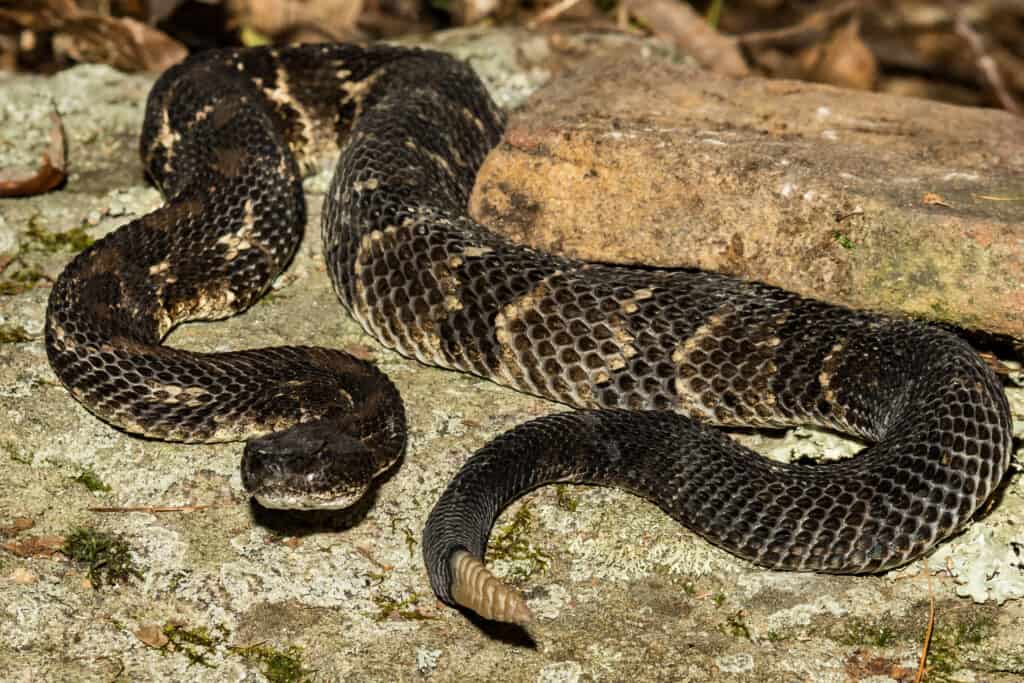
Timber rattlesnakes have large triangle-shaped heads and heavy black or brown bodies.
©iStock.com/JasonOndreicka
These snakes are some of the bigger rattlers in the United States, reaching 36 to 60 inches long. They are venomous pit vipers with broad and large, triangle-shaped heads that are typically gray, tan, or yellow in color. They also have heat-sensing pits between their eyes and nostrils that help them to detect predators and prey nearby.
Their thick, heavy bodies are usually gray, tan, yellow, and sometimes brown, with dark chevron or V-shaped markings. Many snakes also have a brown stripe along the middle of their backs as well. Timber rattlesnakes have tails that end in black, with a large, prominent rattle made up of hollow keratin segments. Each time the snake sheds, a new segment is added. When the snake vibrates its tail, it makes a loud rattling sound.
The timber rattlesnake’s diet consists mostly of small mammals, such as cotton rats, cottontail rabbits, squirrels, chipmunks, deer mice, and voles. They also eat birds (including bobwhites and passerines) and frogs. Another snake that they commonly hunt and eat is the garter snake. While timber rattlesnakes have very powerful venom, they are not aggressive. These snakes will try to camouflage and hide. They may also shake their tails and make a noise to warn people if they get too close. If the person does not go away or the snake feels threatened, it will attack. However, there are not a lot of reports of people being bitten by timber rattlesnakes because they are very shy and do not like confrontation.
2. Eastern Massasauga
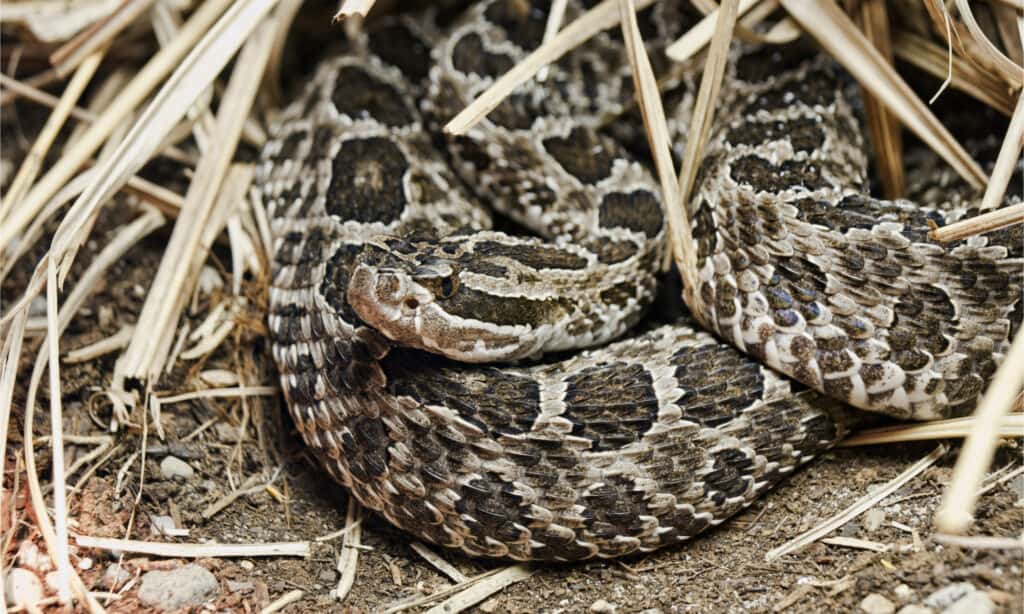
The eastern massasuaga is mainly found in the northwestern corner of Pennsylvania.
©DnDavis/Shutterstock.com
| Range | Northwestern corner of Pennsylvania |
| Length | 20-30 inches |
The eastern massasauga is much smaller than the timber rattlesnake. It is also a rare rattlesnake in Pennsylvania, and is typically only seen in the northwestern corner of the state. It is a federally threatened species protected by state laws as well as the Endangered Species Act. Eastern massasauga snakes prefer wetland habitats for much of the year, but they also like to live in different places depending on the season.
In the spring, fall, and winter, they tend to live in places that are poorly drained and low-lying. They prefer to live in dry habitats in the summer, and move more upland to live in fields, meadows, or prairies. Pregnant females often bask in the sun in dry areas with vegetation before they give birth in August and September. Like timber rattlesnakes, eastern massasaugas also brumate during the winter, often in burrows made by other animals.
Eastern Massasauga Appearance and Behavior

Massasuaga rattlesnakes usually have dark brown or black patterns along their bodies
©iStock.com/Shoemcfly
Eastern massasaugas are smaller rattlesnakes in Pennsylvania, growing 20-30 inches with light gray bodies. They have dark brown or black patterns and small blotches along their backs and sides. Their bodies are thick and heavy, and they have dark and light-colored stripes along both sides of their heads. Juvenile snakes look like miniature adults, except they are only 9 inches long and have a yellow-tipped tail. Many young snakes may lack the characteristic rattle as well, as babies are born with only a button on the end of their tails. Each time the snake sheds (two to three times a year), a new segment is added to create a rattle.
These snakes are also venomous pit vipers and eat small mammals, reptiles, other snakes, and invertebrates. Juvenile eastern massasaugas tend to eat reptiles and other snakes, but when they become fully mature, they prefer to eat small mammals. They use their heat-sensing pits to track down their prey, and then use their venom to subdue it.
Just like other types of rattlesnakes, eastern massasaugas can bite and inject venom into humans and other animals when they feel threatened. However, these snakes are actually quite tame and are even considered incredibly mild-mannered. They won’t usually strike or attack humans unless they are being handled. Eastern massasaugas would much prefer to just slither off when humans get near them or hide and blend into their surroundings.
In addition, you may or may not hear a massasauga rattle its tail. These snakes are so small, that when they vibrate their tails, it sounds more like a buzzing insect than a large rattlesnake!
Rattlesnake Safety
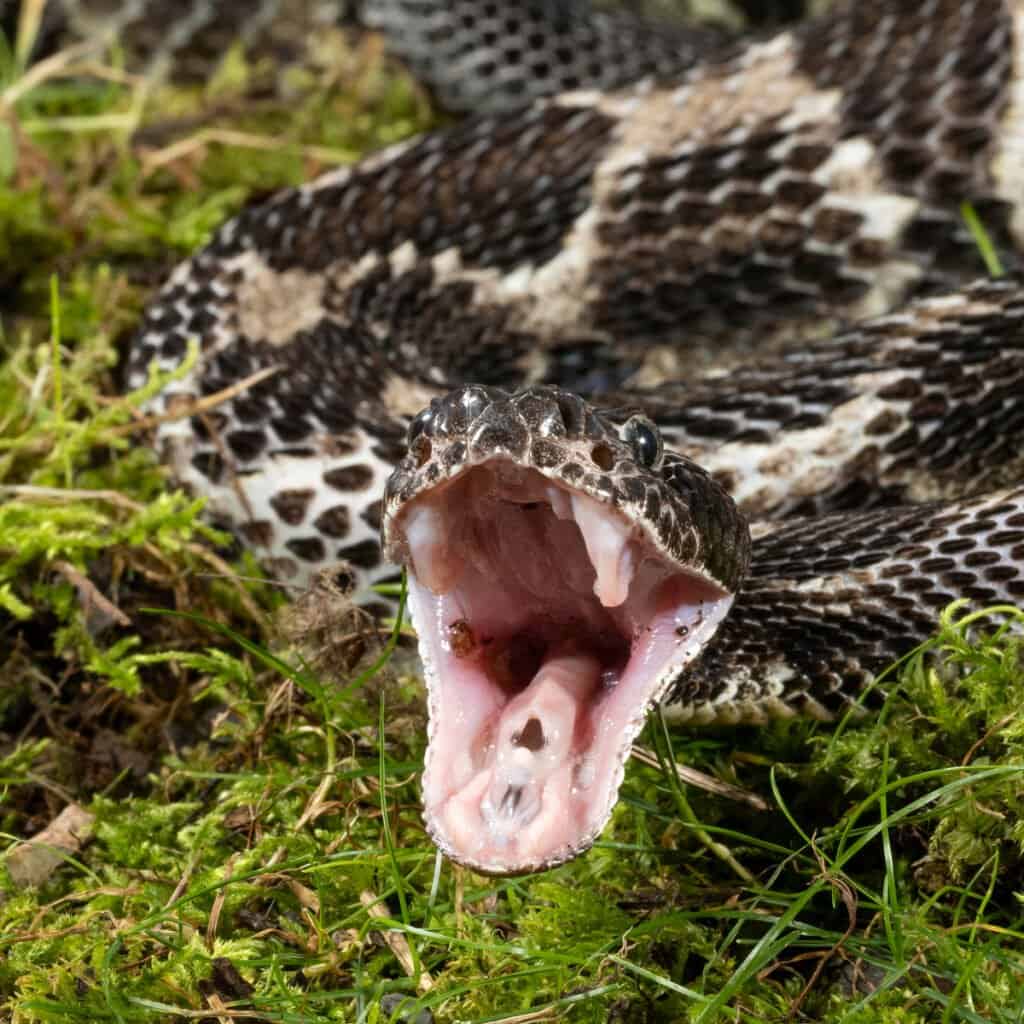
Even though both rattlesnakes are not typically aggressive, it is important to avoid them wherever possible.
©Joe McDonald/Shutterstock.com
The two types of rattlesnakes in Pennsylvania are shy, secretive, and not aggressive. However, they are still venomous snakes that can cause you harm if you bother them. Here are some useful tips to help you stay safe while enjoying your time outdoors in Pennsylvania:
- Always be aware of your surroundings. Check before you sit down or put your hands or feet on rocks, into piles of logs or boards, or under sheds and other equipment. Many rattlesnake bites are due to the snake being accidentally stepped on!
- Even if you find a dead rattlesnake, do not touch it, and never pick it up. Even a dead rattlesnake is venomous, and its body’s natural reflexes can harm you.
- If you encounter a rattlesnake in Pennsylvania, give it a wide berth and leave it alone.
- If you see a snake with white or cloudy eyes, it is currently shedding and cannot see as well. This means that you should be especially careful and give it plenty of room, so you don’t surprise the snake unexpectedly.
- If you are bitten by a rattlesnake, stay calm and do not attempt any of the “Hollywood” snake bite measures portrayed in media (such as suction, incisions, alcohol, tourniquets, etc.). These are not only ineffective against snake bites, but they can also make things much worse. Do not run but get to a hospital as soon as possible.
Other Snakes Found in Pennsylvania

The northern copperhead is one of three venomous snake species in Pennsylvania.
©iStock.com/David Kenny
In addition to these venomous rattlesnakes, there is another venomous snake found in Pennsylvania: the northern copperhead. It is the most commonly found venomous species in the state and is widespread in habitats of grass fields and clearings. Compared to other pit vipers, their venom is not as potent and they are less aggressive. They measure around 3 feet long and are wide and heavy.
Other snakes in Pennsylvania include the northern ring-necked snake, eastern milk snake, and northern water snake, which is the most common aquatic snake in the U.S.
Northern black racer snakes, semi-aquatic queen snakes and ribbon snakes, and the eastern smooth earth snake, a subspecies only present in the southeast, are also some of the 21 snake types that make their home in Pennsylvania. You can find more information on these species and a full list of the snakes in the state here.
Which U.S. State Has the Most Rattlesnakes?

The Arizona ridge-nosed rattlesnake is the state reptile of Arizona, which has the most rattlesnake types in the U.S.
©Matt Jeppson/Shutterstock.com
Rattlesnakes are native to the Americas and there are considered to be at least 32 species of rattlesnakes in existence. While Pennsylvania has two rattlesnake species, other states in the U.S. are home to many more rattlesnake species and subspecies.
The state that contains the most rattlesnakes is Arizona. There are more than 13 different types of rattlesnakes present. These include the desert massasauga, Mojave desert rattlesnake, sidewinder, Grand Canyon, Arizona black, Great Basin, tiger, banded rock, western diamondback, twin-spotted, southwestern speckled, Arizona ridge-nosed, northern black-tailed, and prairie rattlesnakes. The Arizona ridge-nosed rattlesnake is the state reptile.
California is the state with the second-largest number of rattlesnakes. It has 12 rattlesnake types: Western diamondback, sidewinder, Mojave Desert, Colorado desert sidewinder, southwestern speckled, southern pacific, panamint, northern Mojave, Mojave green, Great Basin, red diamond, and northern Pacific.
The state with the third-highest number of rattlesnake types is Texas. Among the 9+ rattlesnakes that can be found in Texas are the western diamondback, timber, desert massasauga, Mojave desert, prairie, western massasauga, banded rock, blacktail, and mottled rock.
Conversely, the states in the U.S. that contain no rattlesnakes are Alaska, Hawaii, Maine, and Rhode Island.
Discover the "Monster" Snake 5X Bigger than an Anaconda
Every day A-Z Animals sends out some of the most incredible facts in the world from our free newsletter. Want to discover the 10 most beautiful snakes in the world, a "snake island" where you're never more than 3 feet from danger, or a "monster" snake 5X larger than an anaconda? Then sign up right now and you'll start receiving our daily newsletter absolutely free.
Thank you for reading! Have some feedback for us? Contact the AZ Animals editorial team.

